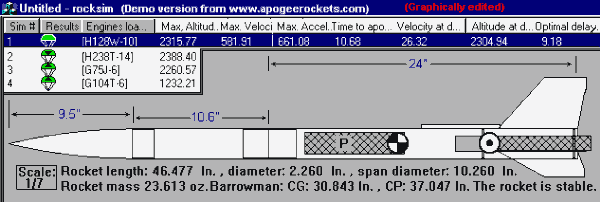| Manufacturer: | Scratch |

 CoStar HPR capable
midpower rocket
CoStar HPR capable
midpower rocket
The CoStar should probably have been called "Understudy."
My other rocket this size, G-whiz, has replaceable fins, and since I wasn't completely sure the concept would work, I built a backup booster section with fixed fins. G-whiz also has some internal details that move the payload area forward into the hollow nose cone, and I wasn't sure that was necessary for all flights, so I built a backup payload section without all the fancy work. The backup booster and the backup payload, together with the nose cone from G-whiz, made up the rocket I call CoStar.
CoStar, not G-whiz, flew twice on April 17, 1999 on H128W-M(10). The first flight (photo, left) suffered a tangled parachute, but there was no damage to the rocket, and the second flight gave me my NAR HPR Level 1 certification. This seemed a lot of power for this size rocket; it went straight up, 'way up, fast.
With fixed 1/8" plywood fins slotted in to the MMT, a longer recovery bay, and a simple empty payload section, CoStar is a very simple, basic rocket. And for Level 1 certification, the KISS principle (Keep It Simple, Stupid) makes a lot of sense. CoStar is, in any case, a fine-looking rocket in its own right. It's over 44" long, 2.26" diameter, and all white except a red band on the payload and some trim, with tapered swept fins slightly squared off at the trailing tips for a better landing point. It flew with a 12' long 5/8" braided elastic shock cord and a 22" hemispherical parachute. There's no baffle; I simply used Estes recovery wadding.
CoStar's motor mount, like the one in G-whiz, is a LOC 1.14 made from a LOC 29-in-54 motor mount adapter kit. The mount is long enough for 29/240 but I don't have one and haven't tried it. The CoStar has flown with 29/180 reloads. Unlike the RockSim drawing below, the centering rings are placed at each end of the fin tabs, 4" apart. The aft one is about 1/2" from the end of the body tube. The centering rings supplied with the kit fit inside the supplied coupler, and I didn't want to cut fin slots through a full-length coupler, so I epoxied each centering ring into one end of a 1/2" ring of the coupler and worked from there. The remainder of the supplied coupler, with a bulkhead fitted in it, connects the booster to the payload.
CoStar was built with a .062" music-wire engine hook, but I also friction taped the motor. Good thing. When recovered from the second flight, the motor had managed to get past the tip of the music-wire hook, which was dug into the knurled thrust ring on the aft closure when I found it. The motor had moved a total of about 3/16 of an inch. Since then I have installed threaded anchors in the aft centering ring for shower door hooks, aka Kaplow Klips. This would be far easier to do before assembly, using T-nuts from the inside.
Since those two flights, CoStar has not flown again, but it's ready. Now it has its own PML nose cone, which adds about 2" to its overall length. (At last they can be seen together!) Although there isn't a real role for it in my upcoming projects, CoStar -- or at least part of it --will undoubtedly fly for the fun of it in 2000. In the meantime it displays rather nicely.

Sponsored Ads
 |
 |











